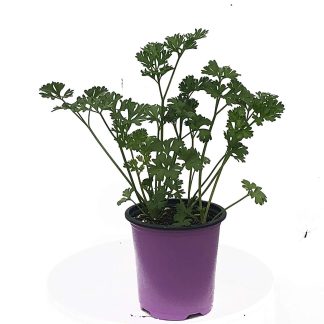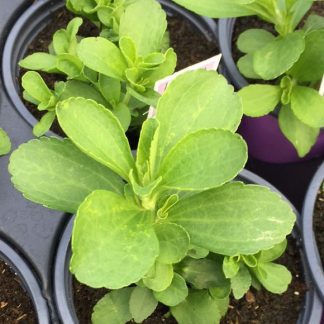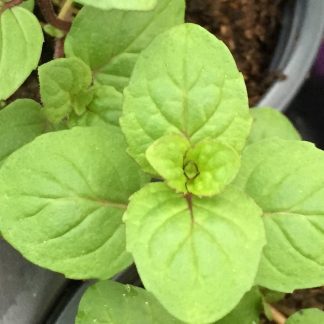Description
Purple Sage (Salvia officinalis ‘Purple’): A Bold Beauty for Garden and Kitchen Alike
There is something extraordinary about plants that blend beauty and usefulness. They brighten a space, draw pollinators, flavor food, and ask almost nothing in return. Purple sage (Salvia officinalis ‘Purple’) is one of these treasures.
Its deep purple leaves stand out in any garden. The rich color offers drama and elegance, while the familiar sage scent ties it back to the kitchen. For those of us who love herbs that work double duty—both ornamental and culinary—Purple sage is a top choice.
This guide explores everything you need to know about this stunning herb. You’ll discover how to grow it, how to use it in your kitchen, and why it deserves a spot in any garden that values both beauty and flavor.
What Makes Purple Sage Special
Purple sage is a unique variety of common sage (Salvia officinalis). Unlike the typical gray-green leaves of traditional sage, this cultivar has striking foliage in shades of dusky purple to deep burgundy. The leaves often deepen in color during cool weather, creating a dynamic look year-round.
This variety is evergreen in mild climates, holding its color through winter. When summer arrives, it produces soft blue-to-lavender flowers that attract bees and butterflies. It’s a plant that gives back to both gardener and pollinator.
Appearance and Growth Habit
Purple sage forms a compact, bushy plant. It usually grows 18 to 24 inches tall and spreads about as wide. The foliage is slightly fuzzy, giving it a soft texture. New leaves emerge with intense purple hues, and older leaves may fade to a muted green-purple mix, adding depth to its overall look.
Its flowers rise on slender spikes above the foliage, adding another layer of beauty in late spring or early summer. These blooms also provide nectar for beneficial insects, making it as valuable to pollinator gardens as it is to herb beds.
Ideal Growing Conditions
Sunlight
Purple sage thrives in full sun. Aim for at least six hours of direct light each day. More sunlight means deeper purple leaves and stronger flavor.
Soil
Well-drained soil is crucial. Purple sage does not like wet roots. Sandy or loamy soil works best, and raised beds or containers are excellent options if your garden soil stays damp. A slightly alkaline soil pH (6.5–7.5) helps it thrive.
Water
This herb is drought tolerant once established. Water deeply but infrequently. Let the soil dry between waterings to avoid root rot.
Temperature
Purple sage grows as a perennial in USDA zones 5–9. In colder regions, protect it with mulch in winter or grow it in pots that can be brought indoors.
Planting Purple Sage
You can start Purple sage from nursery transplants, cuttings, or seeds.
- Transplants: The fastest way to enjoy it. Plant in spring after the last frost.
- Cuttings: Take 3- to 4-inch stem cuttings from healthy plants in summer. Root them in damp soil or water until new growth appears.
- Seeds: Germination can be slow and uneven. Sow indoors 6–8 weeks before your last frost date or directly in the garden when the soil warms.
Space plants about 18 inches apart to allow for airflow and growth.
Care and Maintenance
Pruning
Trim back plants in early spring to encourage new growth. Remove spent flower spikes to keep the plant tidy. Light pruning through the season helps maintain shape and prevents woodiness.
Fertilizing
Purple sage is not a heavy feeder. A light application of compost or balanced fertilizer in spring is enough for healthy growth.
Pests and Diseases
This herb is naturally resistant to many pests. Occasionally, you may see aphids, spider mites, or whiteflies. Good airflow and avoiding overwatering prevent most fungal problems, such as powdery mildew.
Harvesting and Storing
Harvest leaves as needed once the plant is well-established. The best flavor comes from young, tender leaves. Pick in the morning after dew dries but before the sun gets too hot.
Fresh leaves can be used right away or stored in the refrigerator for a few days. For longer storage, dry them in bundles or use a dehydrator. Crumble dried leaves and keep them in airtight containers away from light and heat.
Culinary Uses
Purple sage tastes much like common garden sage—earthy, slightly peppery, and aromatic. It’s a perfect match for roasted meats, hearty stews, stuffing, and winter root vegetables.
Its vibrant leaves also make striking garnishes. Fresh purple sprigs add color to cheese boards, salads, and infused oils.
Try pairing Purple sage with:
- Roasted chicken or turkey
- Brown butter sauces for pasta or gnocchi
- Herbal rubs for pork or lamb
- Cornbread or savory biscuits
Ornamental Value in the Garden
Beyond the kitchen, Purple sage shines as an ornamental plant. Its rich foliage contrasts beautifully with silver herbs like lavender or rosemary. It also pairs well with bright green parsley or feathery dill, adding variety to an herb bed.
Plant it in mixed borders for seasonal interest. It works equally well in decorative containers, especially when combined with flowering annuals like marigolds or petunias. Because it’s evergreen in many climates, it provides year-round texture and color.
Companion Planting Benefits
Sage, including Purple sage, is known for repelling pests like cabbage moths and carrot flies. Plant it near cabbage, carrots, or beans for natural protection. Avoid planting near cucumbers, which may not grow as well alongside sage.
Attracting Pollinators
The flowers of Purple sage are magnets for bees and butterflies. They provide an early summer nectar source, which supports pollinator populations in your area. Planting multiple sage varieties together creates a vibrant pollinator-friendly patch.
Overwintering Tips
In colder climates, protect Purple sage with a thick layer of mulch. In very harsh winters, cover the plant with evergreen boughs or a frost cloth. Container-grown plants can be overwintered indoors near a sunny window. Reduce watering during dormancy but don’t let the soil dry out completely.
Propagation for Sharing
Purple sage is easy to propagate, making it perfect for sharing with friends and neighbors. Divide mature plants every 3–4 years in spring. Cuttings taken in summer root quickly and grow into strong new plants by the following season.
Why Gardeners Love Purple Sage
- Beauty: Its bold color adds drama to gardens and containers.
- Flavor: Classic sage taste perfect for countless recipes.
- Low Maintenance: Thrives with little care once established.
- Pollinator Friendly: Supports bees and butterflies.
- Versatile: Equally valuable for cooking, decoration, and companion planting.
Bringing Bold Color and Flavor Home
Purple sage bridges the gap between ornamental gardening and practical herb growing. It is beautiful enough for the front yard, flavorful enough for the kitchen, and resilient enough for busy gardeners.
With its deep purple leaves, fragrant aroma, and hardy nature, it offers something rare: a plant that looks as good as it tastes. Adding it to your garden isn’t just about color—it’s about creating a space that feeds your senses, nourishes your cooking, and supports the pollinators that keep our gardens alive.
Embrace This Vibrant Herb in Your Own Space
If you want a plant that does more than sit pretty, Purple sage deserves a place in your garden. It’s easy to grow, stunning in every season, and endlessly useful in the kitchen. Add one to your herb patch or container garden and watch it transform both your meals and your outdoor space.




